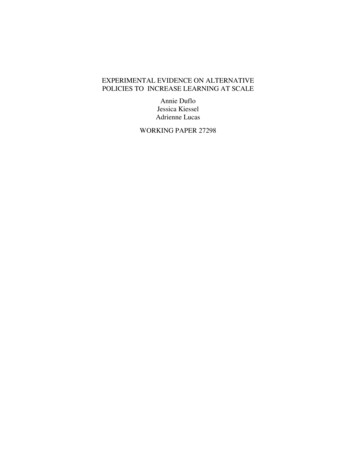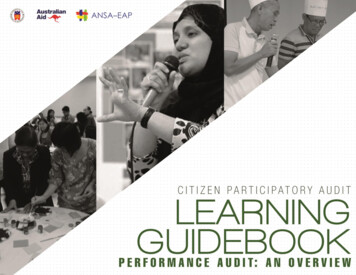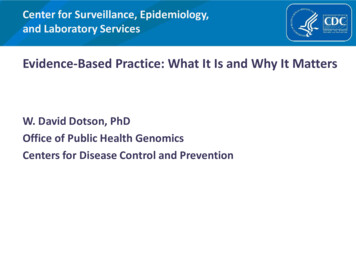
Transcription
EXPERIMENTAL EVIDENCE ON ALTERNATIVEPOLICIES TO INCREASE LEARNING AT SCALEAnnie DufloJessica KiesselAdrienne LucasWORKING PAPER 27298
NBER WORKING PAPER SERIESEXPERIMENTAL EVIDENCE ON ALTERNATIVE POLICIES TOINCREASE LEARNING AT SCALEAnnie DufloJessica KiesselAdrienne LucasWorking Paper 27298http://www.nber.org/papers/w27298NATIONAL BUREAU OF ECONOMIC RESEARCH1050 Massachusetts AvenueCambridge, MA 02138June 2020, revised May 2022We gratefully acknowledge generous funding for the evaluation from the International GrowthCentre, the Hewlett Foundation, and the Children's Investment Fund Foundation. Many thanks toAmma Aboagye, Albert Akoubila, and Maame Araba Nketsiah for supporting and championingthe implementation of program and to Ama Anaman, Raphael Bandim, Suvojit Chattopadhyay,Callie Lowenstein, Sam N'tsua, Pace Phillips, and the entire IPA Ghana team for outstandingresearch implementation and project management. We would also like to thank Wendy Abt forher instrumental role in getting this project started and Caitlin Tulloch and Shahana Hirji fortheir leadership and support with the cost analysis. For research assistance, we thank JoyceJumpah, Ryan Knight, Harrison Diamond Pollock, and Matthew White. We also acknowledgeour partners at the Ministry of Education, Ghana Education Services, and the Ministry ofYouth Sports and Culture without whom this project would not have been possible. Wethank David Evans and Fei Yuan for providing statistics on existing impact evaluationsand James Berry for providing combined math and literacy estimates for the interventionsin Banerjee et al. (2017). For useful comments and suggestions, we thank Noam Angrist,Sabrin Beg, Jim Berry, Janet Currie, David Evans, Anne Fitzpatrick, John Floretta, AlejandroGanimian, Sarah Kabay, Heidi McAnnally-Linz, Daniel Rodriguez-Segura, JeremyTobacman, and numerous seminar and conference participants. This RCT was registered inthe American Economic Association Registry for randomized control trials as AEARCTR0005912. The Innovations for Poverty Action IRB approved this study. This paper waspreviously circulated under the titles “Every Child Counts: Adapting and Evaluating TargetedInstruction Approaches into a New Context through a Nationwide RandomizedExperiment in Ghana” and “External Validity: Four Models of Improving Student Achievement.”The views expressed herein are those of the authors and do not necessarily reflect the views of theNational Bureau of Economic Research.NBER working papers are circulated for discussion and comment purposes. They have not beenpeer-reviewed or been subject to the review by the NBER Board of Directors that accompaniesofficial NBER publications. 2020 by Annie Duflo, Jessica Kiessel, and Adrienne Lucas. All rights reserved. Short sectionsof text, not to exceed two paragraphs, may be quoted without explicit permission provided thatfull credit, including notice, is given to the source.
Experimental Evidence on Alternative Policies to Increase Learning at ScaleAnnie Duflo, Jessica Kiessel, and Adrienne LucasNBER Working Paper No. 27298June 2020, revised May 2022JEL No. I21,I25,I28,J24,O15ABSTRACTWe partnered with the Ghanaian government to test simultaneously four methods of increasingachievement in schools with low and heterogeneous student achievement assistant led remedialpull-out lessons, assistant led remedial after school lessons, assistant led smaller class sizes, orteacher implemented partial day tracking. Despite implementation issues, the interventionsincreased student learning by about 0.1SD, about 0.4SD when adjusting for the imperfectimplementation, with no effects on attendance, grade repetition, or drop-out. Test score increaseswere larger for girls and gains persisted after the program ended. Fidelity of implementationdecreased over time for the assistants but increased for the teachers.Annie DufloInnovations for Poverty Actionaduflo@poverty-action.orgJessica KiesselOmidyar NetworkRedwood City, CAjrkiessel@gmail.comAdrienne LucasLerner College of Business and EconomicsUniversity of Delaware419 Purnell HallNewark, DE 19716and NBERalucas@udel.edu
1IntroductionMany developing countries have eliminated the fee-based barriers to primary school enrollment, resulting in large increases in the number of children in school (Lucas and Mbiti 2012).Unfortunately, education systems originally designed for a smaller cadre of teachers to teacha more homogeneous group of students are failing to educate students in this larger, moreheterogeneous environment comprised of many first generation learners. Effective solutionshave been proposed through smaller randomized controlled trials, yet whether they can increase learning when integrated into existing systems at scale is unknown. This paper tests,in existing systems, four alternatives to support teachers’ transition to the new status quo,a frontier challenge for developing countries. In a single 500 school, nationwide, randomized controlled trial that reached over 80,000 students, we test four models that built onsome of the most effective content delivery interventions in the last 20 years in developingcountries—assistant teachers, smaller class sizes, additional instructional time, tracking, andremedial and differentiated instruction—and show their potential, relative effectiveness, andeffectiveness over time when fully designed and implemented by existing government systems. Results from this study have influenced the implementation of programs to improveeducation in India and Africa with the potential to reach 1 billion students at scale.The Teacher Community Assistant Initiative (TCAI) was a Ghana Ministry of Educationprogram that implemented four interventions to increase student learning using existingschooling and youth employment systems under the unifying theory that focusing more onindividual learners could improve student outcomes. In each intervention, existing educationsector employees designed teaching and learning materials, trained educators in studentcentered, active pedagogy, and provided the educators accompanying teaching and learningmaterials. Three of the interventions used an existing youth employment scheme to hireteaching assistants to work with 1) remedial learners on a pull-out basis during the schoolday, i.e., pull-out remedial, 2) remedial learners outside of the school day. i.e., after schoolremedial, or 3) half of the classroom each day on grade-level content, i.e., classroom split.3
The fourth intervention trained teachers to divide students into three learning levels for partof the day and focus instruction on students’ learning levels, i.e., partial day tracking. Weevaluated the effectiveness of each intervention by randomizing 500 schools into one of thefour treatment arms or a control group and conducting 9 rounds of data collection over threeschool years.All four interventions increased student achievement, showing that remediation can workat scale and existing systems can increase the amount of learning delivered. The interventions increased student learning by about 0.08 standard deviations (SD) after less thanone year (point values 0.05SD to 0.11SD for each intervention) and 0.11SD after two years(point values 0.08SD to 0.15SD for each intervention) on tests that included grade level andfoundational content, about 27 percent of a year of schooling in this context. We cannotstatistically differentiate the four arms from each other when the exams include grade levelcontent. When limiting the assessments to questions focused on foundational literacy andnumeracy, the two remedial arms had a statistically larger effect than the classroom split.The interventions increased girls’ test scores by about 0.1SD more than boys’ scores withthe differential gains concentrated in the interventions with the remedial or tracking component. The interventions did not affect students’ likelihood of being present, dropping out, orrepeating a grade level, common concerns with tracking and remedial programs. Test scoreincreases persisted for students who were treated for about a year and tested one year afterthe end of the program.As is common in government programs, implementation was imperfect: educators taughtto their designated groups during only about one third of spot-check visits even thoughalmost all had received training. That learning gains occurred despite low fidelity of implementation shows that focusing attention on specific learners, whether through smaller classsizes, tracking, or remedial lessons, is a robust strategy that confers learning gains even withincomplete adherence. Because not all students received the intended dosage, we estimatethe treatment on the treated (TOT) using assignment to treatment at the school level as an4
instrument for the students being divided correctly during spot-checks. Using this instrumental variables approach, the interventions increased test scores by 0.3SD after less thanone year and 0.4SD after two years.In calculating costs, the partial day tracking was the least expensive as it relied onexisting personnel while the assistant arms required assistant salaries. All four interventionshad similar costs for trainings and materials. At the point values of the effect sizes, thecost-effectiveness is approximately the same for the pull-out remedial, after school remedial,and partial day tracking with worse cost-effectiveness for the classroom split. If the pointvalues are equal, as could be the case given their statistical equivalence, then the partial daytracking is the most cost-effective.Because the interventions shared common elements, we use a conceptual framework toshow that if the point values are indeed equal, then a smaller class size, remedial instruction—whether as a pull-out program or an extra instructional hour—and tracking are almost perfect substitutes. If the focus is on foundational content where the effect sizes are statisticallydifferent, then these results show three important mechanisms: 1) remedial instruction isequally effective whether it’s implemented as a pull-out or after school program, 2) a smallerclass size focused on remedial instruction is more effective than one focused on grade levelcontent, and 3) even though partial day tracking includes all learning levels, it increasesaverage test scores no more than purely remedial instruction by assistants.In addition to already influencing policy in both Africa and South Asia, our findingsmake three related contributions to the economics literature. First, our four alternatives tosupport teachers’ transition to the new status quo incorporate four of the most promisingfindings from separate NGO-led interventions into a single study (Banerjee et al. 2017; Evansand Mendez Acosta 2021).1 The issue of students not learning while in school has been highlighted as a primary concern in many countries, yet limited evidence exists on how to improve1One potentially promising class of interventions we do not address are those using technology (see Beget al. 2022 for a summary of the literature). Requirements of security, electricity, and internet connectivityrendered such interventions impractical in this context. Most education RCTs in lower income countriesonly contain one treatment arm (Evans and Yuan 2019).5
learning at scale within existing government systems. All four of our interventions offer alternative ways to implement instruction more focused on individual learners—during or afterschool remedial lessons, by dividing the class in half, or having existing teachers specificallyfocus on a more homogeneous group of learners—building on Banerjee et al. (2007, 2010,2017) and (Duflo et al. 2011).2 By comparing the effects and cost effectiveness of the fouralternatives together and in a new context, we further contribute to the understanding ofthe external validity of these methods and which is the most effective and cost-effective wayto increase learning. Tailored instruction increased learning yet implementation difficultiesshow that the capacity of the agency in charge of implementation might matter as much asthe program design.Second, this paper contributes to a broader literature on the importance of at-scale experiments implemented within existing systems. Most of the existing research on similarmethods to increase student learning included at least one of the following: a highly motivated NGO, a researcher team heavily involved in implementation, a narrowly geographicallyselected sample, or additional personnel who were hired outside of normal government operations. This study relied on existing systems and included a randomly selected nationwidesample, features often lacking in experiments in development economics research (Muralidharan and Niehaus 2017). We show the potential for success of similar interventions at-scaleand highlight the additional challenges of at-scale programs.Third, we show that existing government structures have the capacity to increase learning in spite of rigid hierarchies and wages unrelated to productivity (Bau and Das 2020;Muralidharan et al. 2016). Previous programs that embedded NGO-designed programs inexisting, and hesitant, government structures did not increase student learning (Banerjee etal. 2017; Bold et al. 2018). In this version, government involvement started at the outset in2The remedial pull-out intervention was inspired by the NGO-supported assistants in Banerjee et al.(2007) that increased learning in Mumbai and Vadodara cities, India. The remedial after school interventioncomes from Banerjee et al. (2010), which increased letter recognition in Jaunpur district, India. The evidencefrom NGO-supported tracking programs is mixed: full-day tracking increased student learning in WesternProvince, Kenya (Duflo et al. 2011); partial day tracking did not increase learning in Bihar and Uttarakhandstates, India (Banerjee et al. 2017); and partial day tracking increased learning when an extra supervisorylayer and instructional hour accompanied it in Haryana state, India (Banerjee et al. 2017).6
the design of the teaching, learning, and training materials and continued through trainingand implementation, creating a truly government owned and operated program. The increase in test scores demonstrates the potential potency of the interventions if implementedelsewhere entirely within a government system.Yet, we also show that continuing supportbeyond program inception is also crucial—the assistants’ adherence fell over time.2Background2.1The Ghanaian Educational SystemPrimary school in Ghana is grades 1 through 6, starts at age 6, and is free of tuition fees ingovernment schools. Our study focuses on students in government schools in grades 1-3, i.e.,lower primary. The school year starts in September and consists of approximately three 13week terms: mid-September through mid-December, January through mid-April, and Maythough the end of July. In lower primary school, teachers are grade-level classroom teachers,teaching all subjects to a classroom of a specific grade-level of students. Teachers’ salariesare paid centrally, and Ghana Education Service (GES) assigns teachers to schools.As with many other lower income countries with high stakes certification exams betweenschooling levels, teachers are expected to adhere to a national curriculum even if students arewell behind grade level. This pressure often causes them to focus on the highest achievingstudents, those at grade level or above (Gilligan et al. 2022). The official curriculum to whichteachers must adhere and pedagogical methods that teachers use are largely unchanged froma time in which only wealthier, more highly educated parents could afford to send theirchildren to school even though the number of children in schools and the heterogeneity oftheir family backgrounds and pre-school preparations have increased substantially since thestart of free primary education in Ghana in 2005. This results in heterogeneous classroomswith many students left behind—only about a quarter of primary school students reachproficiency levels in English and math (Ministry of Education 2014). In our baseline data, 947
percent of grade 3 students could not read a grade 3 text, 18 percent of grade 3 students couldnot identify letters of the English alphabet, and the within grade-by-school heterogeneitywas larger than the difference in the average test scores between grades 1 and 3.In the year prior to the study, the language of instruction in lower primary grades changedfrom each school’s discretion, usually a combination of English and a local language, tothe school’s assigned National Literacy Acceleration Program (NALAP) language.3 Fullimplementation of this policy lingered into our study years (Hartwell 2010). Because of theNALAP delays, our analysis focuses on math and English skills, providing separate estimatesfor NALAP test scores.2.2National Youth Employment ProgramThe National Youth Employment Program (NYEP) paid the intervention’s assistants, knownas Teacher Community Assistants (TCAs). NYEP was an existing program under the Ministry of Youth and Sports that offered unemployed youth (18 to 35 years old), mostly secondary school graduates, two year public service positions and a small ( 80- 100) monthlystipend. NYEP youth were already used by the Ghana Education Service on a limited basisto fill vacant teacher positions, often in remote areas.3Intervention and Conceptual Framework3.1InterventionThe project was a partnership between GES, the Ghana National Association of Teachers,and NYEP. In preparation for the implementation, Ghanaian education officials visited Indiato learn from Pratham, a large Indian NGO, about the previous successes and challenges ofthe Teaching at the Right Level (TaRL) approach that was studied in Banerjee et al. 2007,3A school’s NALAP language was determined by geography and was not necessarily the mother tongueof all or a majority of the schools’ students.8
2010, and 2017. Government employees under the Ministry of Education umbrella designedthe teaching, learning, and training materials with inspiration from the TaRL approach.This study tested four methods of improving student learning in government schools—pull-out remedial, after school remedial, classroom split, and partial day tracking—relativeto each other and a control group. Treatment was assigned at the school level with 100schools receiving each treatment. Figure 1 summarizes the components of each intervention.The interventions were not strictly nested but did contain common elements across multipleinterventions.[Figure 1 about here]Each intervention involved an educator, i.e., the person who teaches the pedagogy to thestudents. Schools in the three assistant-based treatments—pull-out remedial, after schoolremedial, and classroom split—used the same hiring procedures to hire an assistant whowould be paid through NYEP. School Management Committees (SMCs) and Parent TeacherAssociations (PTAs) identified potential assistants from secondary school graduates aged18 to 35 living in the school community. Candidates were interviewed and selected foremployment by a panel of local, GES, and NYEP representatives. In the partial day trackingintervention, the educators were existing classroom teachers in grades 1 through 3.Existing government trainers provided all educators the same training on how to engagein active, child-focused pedagogy and materials that contained suggested engaging, childfocused activities.4 Assistants in the remedial arms received additional training materialsfor remedial instruction. Classroom split assistants adhered to the official, grade level, curriculum. Teachers in the partial day tracking intervention received materials that spannedremedial to grade level to allow them to differentiate instruction across three learning levels.All educators were responsible for their own lesson plans with the provided materials assuggestions and guides.4In active pedagogy, children take an active role in their own learning instead of passively receivingknowledge.9
Educators were to implement the program at each primary school for one hour each day,four days per week. Educators received training on how to divide the students appropriatelydepending on the intervention. In the remedial and partial day tracking interventions educators tested students at the start of each term to determine their learning levels, assigningeach student to learning level 1, 2 or 3. Remedial assistants worked remedial students acrossthe three lower primary grades. This resulted in smaller, more homogeneous classrooms forall students for part of each day in the pull-out remedial intervention. Remedial studentsin the after school remedial intervention received an extra instructional hour. Assistants inthe classroom split worked with a random half of the students from a classroom on gradelevel material. They were to randomly pick students each day. This provided all studentsa smaller class size. The partial day tracking teachers divided students by learning levelwithin their classrooms in the first two terms of the intervention. Starting the third term ofimplementation, teachers learned through a refresher training to divide their students acrossgrades by learning level with one teacher teaching each learning level.5 Students in this intervention had a more homogeneous classroom environment. The programs were implementedwith minimal support from four Regional Coordinators who were each responsible for 100regionally proximate schools and reported to the Director of Basic Education.All interventions had the same timing and implementation schedule and occurred overthree academic years. Initial trainings occurred in May (Term 3) of the 2010-2011 academicyear (academic year 1) with treatment lessons starting immediately despite material delaysthat lasted into the second academic year. Additional training sessions occurred throughoutthe next two academic years, with the study ending at the end of the 2012-2013 academicyear (academic year 3).The labels above the line in Figure 2 display the academic year and intervention timeline.The labels below the line are the nine data collection points.5For example, the grade 1 teacher might work with level 1 students, the grade 2 teacher with level 2students, and the grade 3 teachers with level 3 students. In both the remedial interventions and the partialday tracking, learners were grouped with peers at their learning level but not necessarily their grade level.10
[Figure 2 about here]Our primary cohort of interest was subject to the intervention or in the control groupstarting with the third term of grade 1. They continued with these interventions throughthe end of grade 3. We further provide effects for the cohort that received the interventionstarting in the third term grade 2, was treated for all of grade 3, and we tested at the endof grade 4, one full year after leaving the program.3.2Conceptual FrameworkEven though the interventions were not strictly nested, the commonalities and differencesbetween them and their relative effect sizes are informative about mechanisms to improvestudent outcomes. The overall effect of each intervention relative to the control group compares the total size of the particular bundle relative to the status quo. Other comparisonsprovide additional insight, effectively the partial derivative from marginal changes to anintervention designed to increase student learning.Comparing the two assistant led-remedial interventions (T1 vs T2 in Figure 1) shows therelative merits of using smaller, more homogeneous class versus an extra instructional hourto deliver remedial material. Both of these interventions were designed to shift the left tail ofthe learning distribution to the right with the pull-out version also providing a smaller classsize and more homogeneous learning environment to all learners. The comparison of the twoduring school assistant interventions (T1 vs T3) shows the marginal effect of remedial versusgrade level instruction. The relative magnitudes of the pull-out remedial and the partialday tracking interventions (T1 vs T4) shows whether a classroom teacher can replicate thebenefits of a smaller, homogeneous class size by focusing on a homogeneous group of learners.When comparing the after school remedial to the classroom split (T2 vs T3), the differenceis the relative benefit of remedial instruction plus an extra instructional hour relative to asmaller class size. The after school remedial relative to the partial day tracking (T2 vs T4)shows the relative merits of an extra instructional hour focused only on remedial students11
versus more homogeneous instruction during the normal school day. The final comparison ofthe classroom split relative to the partial day tracking (T3 vs T4) shows the relative effectof a smaller class size versus a more homogeneous learning environment. These last twointerventions were designed to shift the entire test score distribution to the right, not onlyfocusing on remedial learners.4Empirical StrategyFrom our randomization design, comparing outcomes between individuals in treatment andcontrol schools is straightforward. We estimate an overall effect size across the four treatments in an intent-to-treat specification,0yis α β treatments Xis Γ εis(1)where yis is outcome y for individual i in school s, treatments is an indicator variable equalto one if school s was a treatment school with a single indicator for all treatments (thecontrol group is the omitted category), Xis are a vector of individual level controls, andεis is a cluster-robust error term assumed to be uncorrelated between schools but allowedto be correlated within a school. We always include dummy variables for strata (region byabove/below median pupil teacher ratio by above/below median baseline test score) andgender in Xis . When the outcome of interest is a student’s test score, we implement a laggeddependent variable model and include the test score from the baseline as a control in theXis vector.6We additionally estimate the effect of each treatment separately,yis α 4X0βT treatmentT s Xis Γ εis(2)T 16Our point estimates are similar in magnitude but less precisely measured if we omit the baseline testscores as a covariate.12
with separate indicators treatmentT s for each treatment T (the control group is the omittedcategory) and other notation as above.We test the impact of the treatment on the students’ test scores, attendance, likelihoodof dropping out, and likelihood of being demoted or held back a grade; on teachers’ andassistants’ attendance, time on task, and material usage; and on the likelihood the groupswere meeting as intended.Because of imperfect fidelity of implementation, we also perform an instrumental variablesanalysis of the treatment on the treated (TOT). In this case, assignment to treatment at theschool level is the instrument for whether we observed correctly formed groups during thespot check sessions. We then follow the analog to the above specifications, first estimatingthe overall effect of the treatments then estimating the effects separately.5Sample Selection and DataThe 500 school experimental sample was nationwide in scope, including schools from all tenregions and 42 districts in Ghana.7 From this sample, one hundred schools were randomlyallocated into each of the five treatment designations (four treatment arms and a controlgroup), stratified by region, above/below median average baseline student test score, andabove/below median pupil teacher ratio.To evaluate the effect of the four interventions, we collected nine rounds of data acrossthree academic years: a baseline, six spot-checks, and two achievement follow-ups. In thebaseline and achievement follow-ups we administered surveys to head teachers (i.e., principals) teachers, and students and tested students using bespoke exams in all 500 schools. Thebaseline occurred near the start of academic year 1 (October 2010), the first achievement7In Ghana, district is the administrative subdivision immediately below region. Forty-two (out of 170 atthe time) districts were randomly selected with at least two districts selected from each of the ten regions.The number of districts was limited to facilitate training educators from multiple schools at the same time,as would happen in a nationwide scale-up of the program. Each of the 42 districts was randomly assignedto have either 11 or 12 sampled schools. Within each district, sample schools were selected from Ghana’sEducation Management Information Systems (EMIS) school list, attempting to have an equal number ofurban and rural schools.13
follow-up was in academic year 2 (November 2011), and the second achievement follow-upwas near the end of academic year 3 (July 2013). In academic year 1, we randomly sampled25 students from grades 1 and 2 from those present on the day of initial enumeration. Weattempted to follow these students through academic year 3 when they should have beenin grades 3 and 4 if they progressed on pace.8 The six spot-check rounds occurred termly,starting with the third term of academic year 1 (June 2010) and ending with the second termof academic year 3 (April 2013). In these data collection rounds, we visited a sub-sampleof schools and recorded whether the school was implementing the intended intervention,assistant demographics, classroom activities, whether the student was still attending theparticular school and in the expected grade, and student, teacher and head teacher attendance. Figure 2 above shows the data collection timeline. Appendix Section A.1 containsadditional details on data collection and test design.Data from our five treatment arms are balanced based on student, teacher, school, andassistant characteristics (see Appendix Section A.2). To provide some context, almost allstudents had sho
Experimental Evidence on Alternative Policies to Increase Learning at Scale Annie Duflo, Jessica Kiessel, and Adrienne Lucas . Redwood City, CA jrkiessel@gmail.com Adrienne Lucas . .1 The issue of students not learning while in school has been high-lighted as a primary concern in many countries, yet limited evidence exists on how to improve .




![project2 Encase.pptx [Read-Only]](/img/12/project2-encase.jpg)





